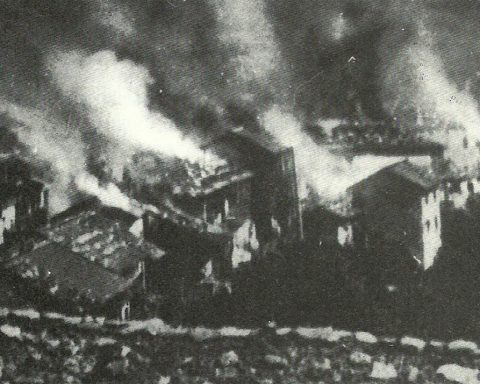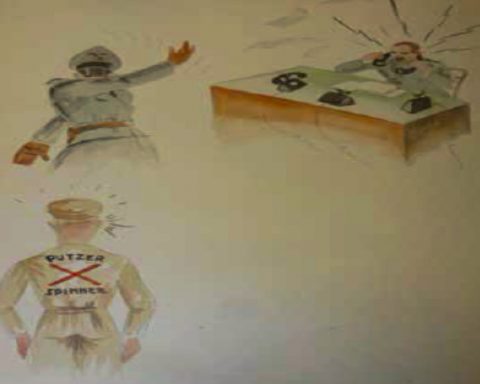There was certainly a substantial presence of workers from Belluno in the Reich in the years 1938-1945, but this reflected a long-standing seasonal migratory tradition; at the end of July 1941, they totalled 3,826.
In 1942, the departures of workers belonging to Fascist trade union organisations or recruited by Italian firms operating in Germany began to decrease significantly.
In any case, at the end of 1943 there were 1936 industrial workers in the territories of the Reich, mostly trapped there after 25 July. They would be joined the following spring by 500-600 seasonal agricultural workers, for a total of about 2,500. Those living in the Reich on 31 December 1943, i.e. the 1,963 workers mentioned, were given an advance of 500 or 1,000 Lire on the remittances that had been Interrupted by the events following 8 September – i.e. the occupation and aggregation of the province of Belluno to so-called Operation “Alpenvorland”.
Images 1, 2 (ASB, Gabinetto Prefettura, b. 340, fasc. XII-4-A, sottofasc. 562)
In the meantime, the province of Belluno, occupied by German troops after 8 September 1943, had become part of the Prealps Operations Zone (Operationszone Alpenvorland – OZAV) together with Trento and Bolzano.
Ordinance no. 25 of 30 October 1943 ordered a census of all the male and female workforce available for the Labour Service.
Images 3, 4, 5 (ASCB, Atti, Anno 1944, Cat. VIII, Guerra, Ordinanze del Comando Germanico), 6, 7 (ASB, b. 340, fasc. XII-4-A, sottofasc. 535)
Under Order no. 41 of 7 January 1944, supplementing no. 30 of 6 November 1943, war service became compulsory in Organisation Todt (OT), the Security and Order Service (SOD) in the province of Bolzano, the Trentino Security Corps (CST) and similar security organisations, the Police, the SS, the German Armed Forces or the departments of the new Italian Armed Forces.
Images 8, 9,10, 11 (ASCB, Atti, Anno 1944, Cat. VIII, Guerra, Ordinanze del Comando Germanico)
Ordinance no. 25 of 30 October 1943 ordered a census of all the male and female workforce available for the Labour Service.
Given the availability of manpower, work in Germany initially remained on a voluntary basis, while attempts were made to recruit manpower, promising good earnings, especially for Bolzano.
Images 12 (ASB, b. 340, fasc. XII-4-A, sottofasc. 535), Image 13 (ASCL, b. 18, Cat. Truppa e Leva)
The need to acquire male and female workers in North Tyrol, on the one hand, and the unwillingness of the people of Belluno to go to Innsbruck and Landebeck, on the other, gave rise to conscription, and the sending of workers especially to North Tyrol, where those who had disregarded the various enlistment notices also ended up. Images 14 (ASCT, b. 136, Anno 1944, Cat. VIII, f. Leva e Truppa – Servizi militari)
Given the working conditions, starting in May 1944 many of those who had returned home for holidays never went back, either claiming they were sick or going into hiding.
Images 17 (ASB, Gabinetto Prefettura, b. 340, fasc. 562)
The stragglers and dodgers captured by the German forces would end up in Berchtesgaden. Such was the case of Giovanni Scussel, Marcello Rumor, Severino Benvegnù, Alfredo De Gottardo, Giovanni Fontanive, Umberto Moretti and Mansueto Brancaleone. Arrested on 31 March, they found themselves at the Riemerfeld Obersalzberg labour camp near Berchtesgaden on 3 April. Four of them, except Benvegnù, attempted to escape on 18-19 April. Recaptured (Romor in particular was savagely beaten to the point of being disfigured), on 25 April they were transferred to Dachau KL. All were registered under the category “Schutzhäftling”, i.e. deported for security reasons. On 23 May they entered the Flossenbürg KL where they were employed as miners and assistant miners in the quarries for the extraction of granite. On 13 June they were transferred again, this time to Hersbruck, a subcamp of Flossenbürg. De Gottardo, however, remained in the main camp, where he died on 20 August.
Only Umberto Moretti managed to survive, having to endure a last transfer to Dachau, where he arrived on 24 April 1945, a few days before the camp was liberated. Fontanive and Rumor, on the other hand, had died respectively on 8 and 13 October in Hersbruck, while Brancaleone returned to Flossenbürg on 10 November to die there on the 29th of the same month. Scussel had died on 6 November in Hersbruck.
Giovanni Scussel wrote four postcards from Berchtesgaden in which he reassured his mother about his conditions. The latest is dated April 18, shortly before his escape.
April 18 – 4 – 44
Dear mother, I am also sending you these few lines today to let you know that I remain in excellent health, as I hope do you and your sisters, always. The days are wonderful here, and it’s a pleasure to work in such beautiful weather. I always have enough food, and here they also give us pudding, even cooked eggs, and salami and meat every day, and sometimes even twice. I have never eaten so much meat, and once a week they make us pasta but with white pasta like the type Maria had brought down from Cortina. Many warm wishes to you and your sisters.
Your son Giovanni.
Images 15 (ASCSPC, b. 380, Atti, Anno 1944, Cat. VII, Classe VI), 16 (Property of the grandson Moreno Gambaretto)
Only in the summer of 1944, in the face of intensified partisan operations, were those captured in the roundups sent to the Durchgangslager of Bolzano and from there either to the KL, above all Mauthausen, Flossenbürg, Dachau, or to the labour camps, mostly Bitterfeld and Kahla. As part of the harsh repressive operations unleashed in the summer of 1944 against the partisan forces and the civilian population, “guilty” of supporting them, on 11 August 1944, German troops burned down the entire village of Aune (154 houses and 60 farmhouses) in the municipality of Sovramonte. Some of the Inhabitants were captured and taken to the prisons of Baldenich (Belluno), and from there to the Durchgangslager of Bolzano and finally to Greppin (Bitterfeld), Lager Hermine, where they arrived on 4 October 1944. They included: Domenico De Bortoli, born in 1897 (he would die there on 15 March 1945); Argide De Bortoli, born in 1914, stonemason; Candido Collet, baker, born in 1927, and his father Eugenio, miner, born in Romania in 1896; and Lorenzo Gorza, stonemason, born in 1903. The young men captured in Mugnai on 7 August as part of the same repressive operation were also transferred with them.
Images 18 a b: The fire at Aune (ISBREC, Archivio fotografico, fondo “Resistenza”, album 5, serie “Documentazione dei danni causati dal conflitto”)
Images 19: The eldest daughters of Lorenzo Gorza in front of the ruins of Aune (Property of Graziella Gorza)
Images 20: File of Lorenzo Gorza in the Hermine Lager (Arolsen Archives, Reference Code
02020201 oS, Number of documents 2943068)
Images 21: Argide De Bortoli (Property of Eleonora De Bortoli)
Images 22 Candido Collet (Property of Eleonora De Bortoli)
Images 23, 24, 25 Files for Bruno Polesana, Vittorino Dalla Caneva and Pietro Donada di Mugnai, (Arolsen Archives, Reference Code 02020201 oS, Number of documents 2943068, Reference Code 02020201 oS, Number of documents 2943068, Reference Code 02020201 oS, Number of documents 2943068)
Images 26 Statement by Giuseppe D’Angelo di Mugnai (Private archive)
Sources:
ASB Archivio di Stato Belluno
ASCB Archivio Storico Comune di Belluno
ASCL Archivio Storico Comune di Longarone
ASCSP Archivio Storico Comune San Pietro di Cadore
THE HISTORIANS’ VIEW
The centuries-old practice of migration in the Belluno area in a context of endemic unemployment.
The size of the Belluno workforce in Germany in December 1943.
The various categories of forced labourers from Belluno.
by Adriana Lotto







